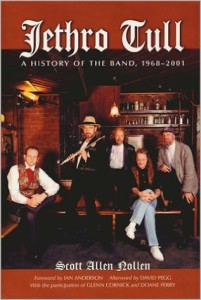 Kate Brown penned this review.
Kate Brown penned this review.
Scott Allen Nollen has proven his devotion as a Tull fan in the countless miles travelled and the hours passed collecting details and interviewing band members and other associates. He has included nostalgic pictures of the band, some of which were borrowed from Ian Anderson, the often frenzied flautist who, despite some controversy, became the Fagin-like front man for the band. After ten long years of research, here in Jethro Tull: A History of the Band, 1968-2001 is a comprehensive and entertaining story of the much misunderstood Jethro Tull. The authenticity is underlined by the thoughtful and honest foreword written by Ian Anderson himself.
From its inception, Jethro Tull has been led unintentionally by the creative and even eccentric Anderson. His on-stage character took on a magical effect as he danced with his flute in the coloured stage lights. Since their first song was televised on Granada Television’s Firstimer’s talent program, May 24, 1967, Anderson has stolen the spotlight. His antics were frowned upon by some, but enthusiastically embraced by many young rock ‘n’ roll fans. Nollen has included a short biography of Ian Anderson in the opening pages of this work.
In this energetic work are interviews with Ian Anderson and several other band members: Glenn Cornick, Jeffery Hammond, Dave Pegg, Barrie Barlow, and more. Band members offer amusing anecdotes, and no one is more honest in his self-examination than Ian Anderson.
The career of this phenomenal band has outlasted what anyone in the music industry ever believed possible. In 1968, Jethro Tull played to 80,000 people at Sunbury Jazz and Blues Festival, sharing the stage with Eric Clapton and Ginger Baker, and getting their first real press coverage. At this time, they were working on their first album, This Was. In 1980, Jethro Tull won a Grammy Award for their album Crest of a Knave.
Nollen examines each album and subsequent tour with careful objectivity mixed with levity, and an obvious understanding of the process by which Jethro Tull developed musically over the past three decades. Details include Anderson’s April Fool’s sprained ankle in 1975 to the statistics for each and every album and tour. The names of Tull members throughout the years, song copyright information, and greatest hits/best of releases are covered in appendices that follow the information on the band in its present form and Anderson’s single recordings.
If there was ever a question of their status, this book has provided the proof that this was, and is, a band with versatility and staying power. For every band member that left, a replacement was quickly found. Through years of losses, gains, bad publicity and honours, Jethro Tull remains. Jethro Tull: A History of the band, 1968-2001 is a must for any serious collector or Tull fan.
(McFarlane & Co, 2002)
